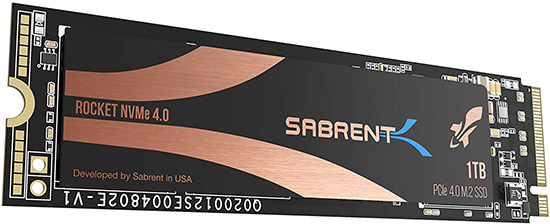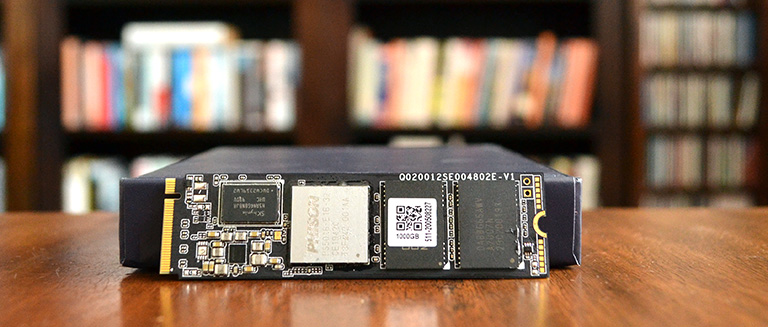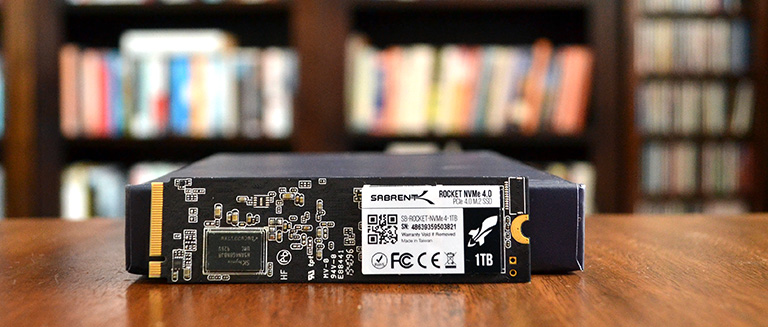Introduction
Think of M.2 NVMe SSD manufacturers and we'd hazard that Sabrent will not come top of your list. Though not immediately familiar to all enthusiasts, Sabrent has built quite a reputation for its SSDs on Newegg and Amazon through thousands of positive reviews citing solid performance and great value. Offering its popular Rocket series in both PCIe 3.0 and PCIe 4.0, we decided to investigate what the fuss was about.
Sabrent's four families of performance M.2 drives are the Rocket Q (up to 8TB, QLC, PCIe 3.0), Rocket (up to 4TB, TLC, PCIe 3.0), Rocket 4.0 (up to 2TB, TLC, PCIe 4.0) which, as the name intimates, offers more bandwidth for super-fast transfers on the latest AMD platforms. Also announced just this week, the fourth is the Rocket Q4 (up to 4TB, QLC, PCIe 4.0), creating a world first by merging large capacity alongside the faster interface. Choices, choices.
Specifications |
||||||
|---|---|---|---|---|---|---|
| Series | Sabrent Rocket NVMe 4.0 |
|||||
| Nominal Capacity | 500GB |
1000GB |
2000GB |
|||
| Controller | Phison E16 |
|||||
| NAND | Kioxia 96-layer 3D TLC |
|||||
| Interface | PCIe Gen 4 x4 |
|||||
| DRAM | SK hynix DDR4 |
|||||
| Sequential Read Speed | 5,000MB/s |
5,000MB/s |
5,000MB/s |
|||
| Sequential Write Speed | 2,500MB/s |
4,400MB/s |
4,400MB/s |
|||
| Random IOPs (4KB Reads) | 400K IOPS |
750K IOPS |
750K IOPS |
|||
| Random IOPs (4KB Writes) | 550K IOPS |
750K IOPS |
750K IOPS |
|||
| Peak Power | 6.2W |
6.1W |
6.7W |
|||
| Idle Power (PS3) | N/A |
|||||
| Sleep Power (PS4) | N/A |
|||||
| Available Form Factors | M.2 2280 |
|||||
| Endurance | 850TBW |
1,800TBW |
3,600TBW |
|||
| Life Expectancy | 1.7m hours |
|||||
| Warranty | 1/5 Years |
|||||
| Current Retail Price | £100 £115 (heatsink) |
£170 £190 (heatsink) |
£360 £370 (heatsink) |
|||
Back to our review model, the Rocket NVMe 4.0 is available in 500GB, 1TB and 2TB capacities. Sabrent opts for the proven combination of Phison E16 controller and Kioxia 96-layer 3D TLC NAND. Headline speeds are suitably speedy as the drive achieves a peak 5GB/s read and 4.4GB/s write for large files. Sabrent's quoted random IOPs are also a match for other PCIe 4.0 drives, though do note that the maximum figures are a bit lower for AMD platforms at 600K/500K for random reads and writes, respectively. The quoted IOPS are actually for Intel on PCIe 3.0 with a Gen4 switch.
Presented in a standard M.2 2280 form factor, the Rocket 4.0 has a thin copper sticker on the upper side. Unlike the paper stickers on most of the competition, it's thick enough to transfer heat out from the underlying controller and DRAM; we know this because it becomes warm to the touch after extended load.
Endurance is handsome for our 1TB model coming in at 1,800TBW, or about one complete drive write per day over five years. One annoying downside is standard warranty cover is merely one year if you don't register the drive within 90 days. If you do, it's extended to the industry-standard five years. We firmly believe Sabrent ought to have five-year cover from the get go.
Removing the sticker shows the upper side of the Rocket 4.0 1TB drive. The ubiquitous Phison PS5016-E16 controller is flanked by two Kioxia NAND (2Gbit each) chips on one side and SK hynix DDR4 DRAM for buffering duties. There's not a whole heap of extra room here, but it's good to know that all four ICs make decent contact with that metallic sticker.
Flicking on over to the other side shows the remaining two NAND chips and another identical DRAM device.
Notice the heatsink options in the above table? Each drive is available as a bare M.2 2280 offering or, if you spend an extra £10-£20, depending upon model, with a pre-installed heatsink for better thermal performance. Sabrent sells the heatsink as a standalone solution, too.
Our sample arrived with the drive in one box - ensconced in a nice aluminium case - and heatsink in another, and putting them together is a cinch. The 102g heatsink comprises two sections; a bottom aluminium tray with thermal tape and heavier upper section that includes three copper heatpipes and its own thermal tape.
Simply line the drive up with the tray, then place the upper section such that the tray's screwholes match up with it. Lastly, screw the two together and you're good to go. Bear in mind that opting for the heatsink model increases overall height to 24mm and width by a millimetre or so, and we'd only recommend it in instances where your motherboard doesn't have its own M.2 cooling. That may sound obvious, but the heatsink-clad drive is a tight fit in boards with their own custom cooling, and it's a definite issue with our test Asus Crosshair VIII Formula motherboard whose large, fitted board heatsink precludes the use of aftermarket M.2 coolers.
Tested without the heatsink, the drive hits a peak 82°C under load, though running the same test on an Intel Z490 board shows a maximum 78°C (no PCIe 4.0 support, for starters) which drops down to 71°C with the supplied heatsink.
Sabrent also supplies a simple control panel for updating firmware, checking on the vital stats, and there's a free copy of Acronis on the website, too. Handily, anyone having problems cloning from an older drive can change the Rocket's sector size to either 512 bytes or 4K.
Priced at £170 without the heatsink, or £20 more with it in the box, the outlay is 50 percent higher than an entry-level PCIe 3.0 x4 NVMe SSD but, crucially, the Rocket 4.0 is considered good value in the Gen 4 space. Let's now see how fast it is.







